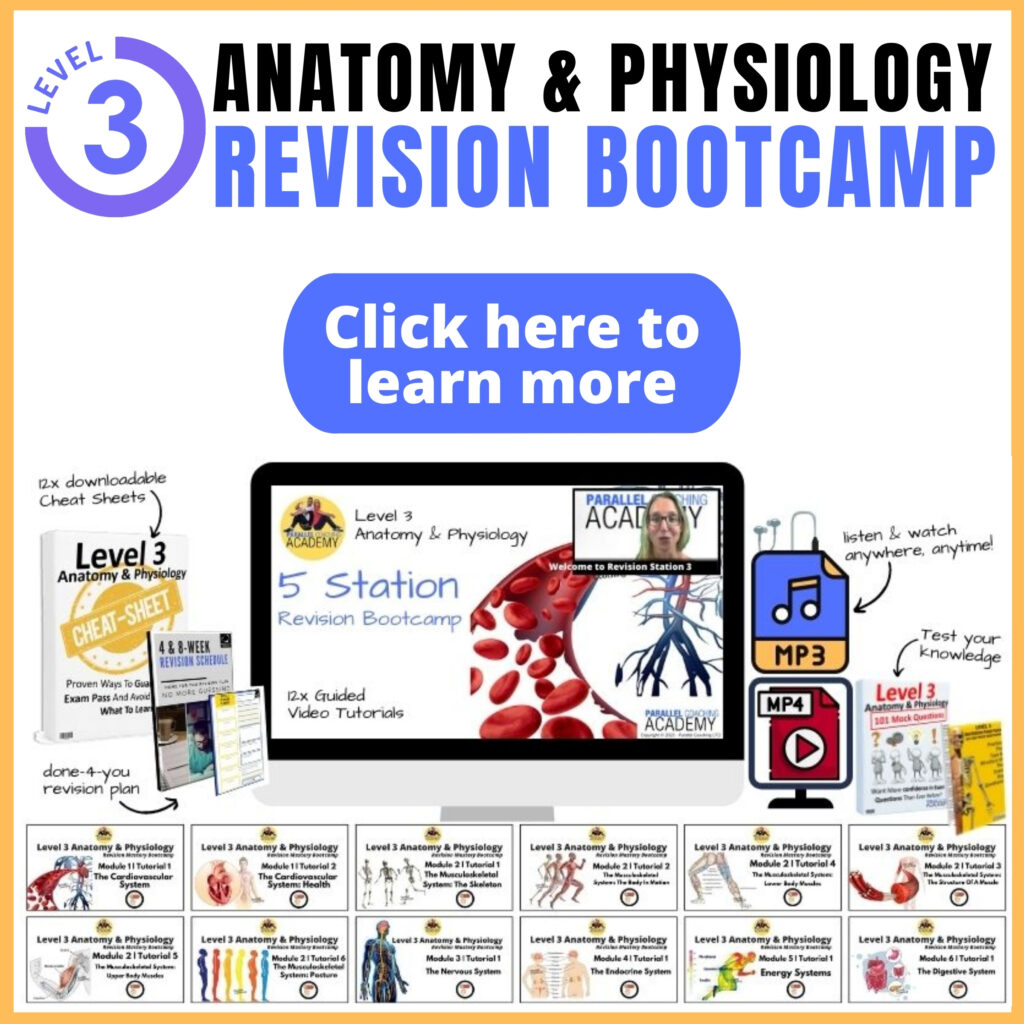This blog will show you how the difference between Shoulder Flexion or Extension and teach you how to remember joint actions for your Level 2 or 3 anatomy and physiology exam
You’ll discover:
- Why FitPros find joint actions hard to revise
- A 2 min Video Tutorial to get clarity on which movement is shoulder flexion or extension
- A quick exam tip to help you remember the difference between flexion and extension
- Understand which movement occurs at the shoulder joint whilst reaching toward the ceiling
- How to learn with simplicity for the rest of the modules
- Three Example Mock Questions about the Joint Actions
Why FITPROs find Joint Actions hard to revise
Joint Actions are notoriously claimed to be one of the hardest modules within the Level 2 and 3 Anatomy and Physiology exam syllabus, so you are not alone if you find this area difficult to understand.
Unlike other areas of anatomy (like bones), it can be hard to make sense of the joint actions from an image in a manual. It may also feel like this is less directly related to training clients as a FitPro.
Although you might not actually be quoting the technical joint action terms with your clients, the knowledge of this is foundational and absolutely crucial in order to create balanced workout plans and understand how the body moves.
2 mins Video Tutorial: Shoulder Flexion or Extension
In this 2-minute video you’ll get clarity on which movement is shoulder flexion or extension; also get a quick exam tip to help you remember the difference between flexion and extension
Exam Revision MythBuster: Shoulder Flexion or Extension…
Quick exam tip to help you remember the difference between flexion and extension
All joints in the body are in EXTENSION when you stand in a neutral position (the anatomical position).
All joints are in FLEXION when you curl into a fetal position. With the exception to shoulder flexion which is arms overhead.
Stand up now, with a neutral spine, feet hip-width apart and arms by your side.
In this position, your shoulder joint is in extension with your arms by your side.
Planes of Motion
Flexion and Extension can only occur in the sagittal plane.
Therefore from your standing position take your arms towards the ceiling in the Sagittal plane.
This is like doing a Frontal Raise action. with Dumbbells
Keep going until the arms are overhead and either side of your ears. This action is SHOULDER FLEXION
Therefore Shoulder extension is the reverse action lowering the arms back to your side, but staying in the sagittal plane.
Which movement occurs at the shoulder joint whilst reaching toward the ceiling?
This is a common exam question that tests your knowledge of shoulder joint movements.
First, know that the Shoulder Joint is a freely moveable ball and socket joint and can move through all three planes of motion.
There are two possible answers, depending on the plane of motion used, however, in the exam there will only be one of these that you can select as the correct answer.
Shoulder Flexion: This is the action of reaching towards the ceiling in the SAGITTAL Plane, and is the same action as performed in a Frontal Raise
Shoulder Abduction: This is the action of reaching towards the ceiling in the FRONTAL Plane, and is the same action as performed in a Lateral Raise, where arms are brought out to the side.
In summary
- Joint Actions might appear difficult, but learning them will really help you as a FitPro and help you pass both level 2 and level 3 anatomy exams
- Flexion and Extension actions are the easiest to learn first, in relation to the anatomical standing position (extension) and the fetal position (flexion). However, Shoulder Flexion is bringing the arms overhead
- Here’s what Lydia had to say about the A&P Revision Bootcamp
I can’t recommend Parallel Coaching enough their learning material is fantastic and definitely was a huge factor in me passing my A&P level 3.
Lydia
Test your knowledge with today’s joint action mock questions:
[NOTE: The answers are below the 3rd questions]
1. Which joint action occurs at the shoulder during the downward phase of a Frontal Raise?
A. Extension
B. Flexion
C. Adduction
D. Lateral Flexion
2. Which movement occurs at the shoulder joint whilst reaching toward the ceiling?
A. Depression
B. Adduction
C. Flexion
D. Extension
3. What type of joint is the Shoulder Joint?
A. Saddle
B. Hinge
C. Ball and Socket
D. Gliding
What’s the CORRECT answer?
Answers to the mock questions are :
Question 1= A, Question 2 = C, Question 3 = C
If you want more mock questions like this, then you can download more Free Mock Questions: DOWNLOAD NOW
Need More Help with your Level 3 Anatomy Revision?
or Trainee FITPROS Taking Their L3 Anatomy & Physiology Exam.
Learn, Revise & Pass Your Level 3 Anatomy & Physiology Exam In Under 10-hours
(Without Having To Spend Hours Revising Or Feeling Overwhelmed)
If you want to get your revision structured, learn everything you need to know and feel confident on exam day, then click the link below:
https://courses.parallelcoaching.co.uk/products/level-3-anatomy–physiology-revision-bootcamp

Dedicated to More
Hayley “Shoulder Flexion or Extension” Bergman
Parallel Coaching
P.S. You can also find us on the following platforms:
Instagram: Follow Now
Facebook: Like Our Page
Twitter: Tweet Us
YouTube: Subscribe Here
More Joint Actions Blogs: HERE

